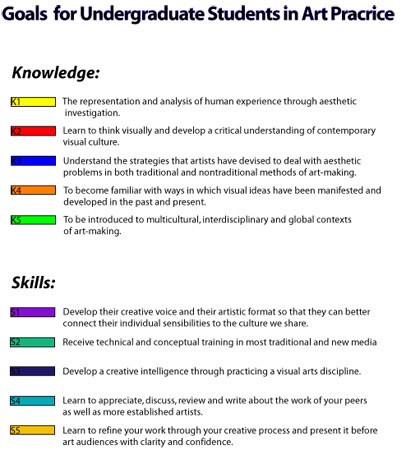Programs and Courses: Undergraduate Program
For undergraduate goals in Art Practice, please click here.
The UC Berkeley Department of Art offers an undergraduate program in studio art which provides a firm grounding in basic techniques and principles while encouraging guided experimentation.
Course offerings in painting, drawing, printmaking, sculpture (ceramic and mixed media), video, performance art and digital media are available to majors as well as non-majors. Art Majors are expected to round out the required studio courses with Art History and Theory classes.
Students graduating with a major in art pursue careers as professional artists and teachers or in arts-related activities with museums, galleries, arts management, publishing, artists' organizations, etc.
The mission of Art Practice:
As practicing visual artists, we, the faculty of the Department of Art Practice hold as our principal goal the representation and analysis of human experiences through creative research in visual art.
In making art, we seek to expand boundaries of our cultures and limits of our perceptions through rigorous experimentation with art forms, media, and content. Considering human experiences from an emotional, experiential standpoint, our experimentation leads us and our audiences to questions about our beliefs, rituals, philosophies, as well as our social, economic and institutional structures. In teaching, our mission is to help students pose such questions by developing their creative voices, by mastering their practices, by relating to their audiences, and by connecting to histories of art and cultures.
Art Practice seeks to graduate students who demonstrate an original, inventive, and singular vision in their approach to practice, form and content, and who have the potential for significant artistic and cultural impact. A successful Art Practice graduate is articulate about his/her work, and has an understanding of the professional landscape he/she is entering. This graduate is a young artist: deeply engaged with his/her art form, rigorously committed to his/her craft, and capable of transcending boundaries of mind, media or method through creative research.
Our methods:
Our curriculum is designed to teach students to think visually, and to help students develop a creative intelligence through the disciplined practice of a visual art. We provide technical and conceptual training in most traditional and new media: painting, drawing, printmaking, sculpture, installation, performance, video, animation, sound, and in the emerging fields of programming, interactivity, and game design.
All undergraduate art courses are comprised of studio and lecture components. Additionally, while the undergraduate major is made up largely of studio courses, it also requires at least three courses in art history. Our students are required and expected to be broadly familiar with the aesthetic strategies that artists have devised to understand and invent their worlds, not just in the 20th and current centuries, but throughout the millenia of human culture. Field trips to area museums, galleries, and artists' studios provide an important on-site learning tool, one which emphasizes the primacy of direct contact with works of art for understanding them, and learning from them.
Small studio classes with frequent critiques are designed to foster a supportive community, productive debate, and collaborative thinking. Students are encouraged to be both open-minded and tough-minded, to look closely, think critically, and challenge assumptions.
May upper-level studio courses will involve an exhibition requirement; early on students are asked to consider questions of audience, context, site, and timing. Several gallery spaces, among them the Worth Ryder Art Gallery, offer exhibition venues, and the department also maintains web space for on-line exhibitions and video streaming.
(click on image for larger version)


